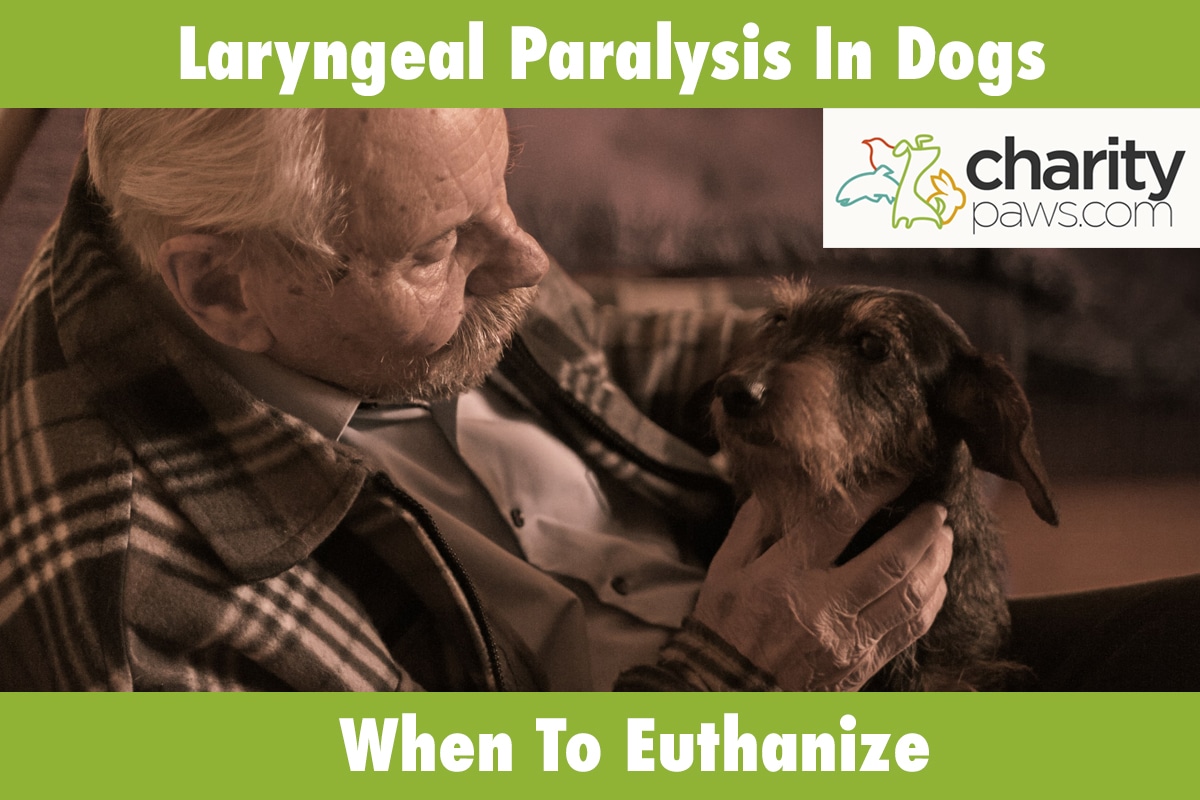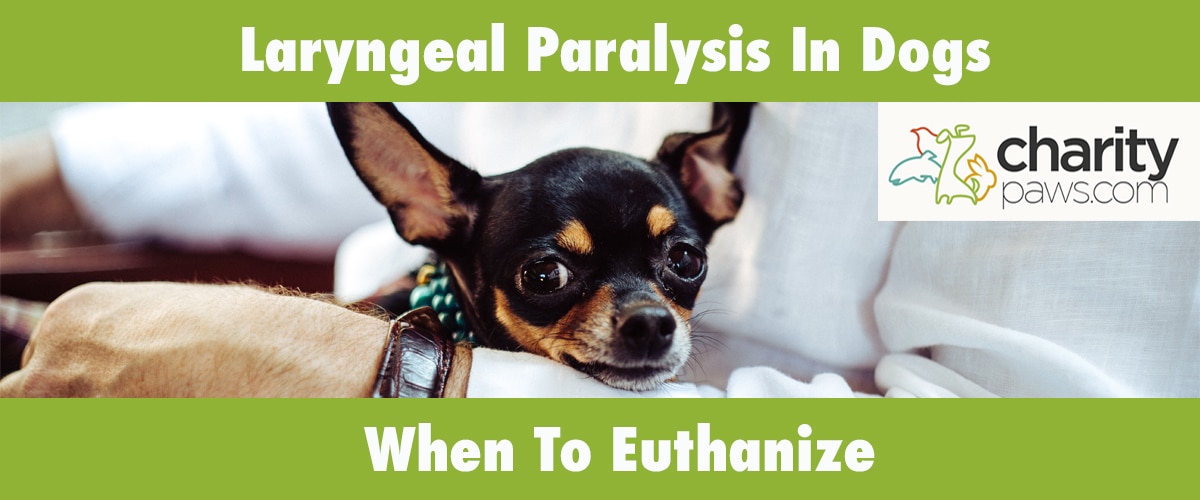Laryngeal paralysis is a common medical complication in older, large breed dogs.
Laryngeal paralysis can significantly impact a dog’s quality of life, even leading to the need for euthanasia in some canine friends.
So what is laryngeal paralysis in dogs, what does this diagnosis mean for your pup and at what point should you euthanize your dog?
In this article we will introduce you to the details of this medical condition, and help you better understand when it may be time to say goodbye to your dog with laryngeal paralysis.
Understanding The Canine Larynx

Before we discuss the details of laryngeal paralysis in dogs, it’s important to understand the structure and purpose of the canine larynx.
The larynx is the portion of the throat that contains the vocal cords, and is often referred to as the voice box.
The larynx is also the barrier separating the throat from the trachea, blocking off the windpipe while a dog eats or drinks.
In dogs, the larynx itself has three main functions:
- This includes voice production
- Controlling air resistance
- Preventing food and water from entering the lungs
As you can see, the larynx serves an important purpose in many everyday body functions.
What Is Laryngeal Paralysis In Dogs?
The larynx is made up of a combination of muscles and cartilage that offer the voice box its structure.
If the nerves in the larynx begin to weaken over time or become paralyzed for any reason, this will cause the muscles to relax.
When this relaxation occurs, the cartilage in the larynx will begin to fold in on itself and collapse, leading to laryngeal paralysis (LAR PAR).
A dog can have varying stages of laryngeal paralysis, but the term refers to the folding and collapse of the larynx itself.
Why Do Dogs Get Laryngeal Paralysis?
Like many other strange conditions in our canine friends, most cases of laryngeal paralysis are idiopathic, meaning they occur without a known cause.
Though most cases of LAR PAR will suddenly develop in an otherwise healthy dog, there are some factors that have been linked to the development of the disease.
- Trauma to the neck or chest
- Tumors or lesions in the neck or chest
- Hormonal diseases such as diabetes, hypothyroidism, and Cushing’s disease
- Hereditary link to the condition
- Underlying nerve conditions
Some dogs will have congenital laryngeal paralysis, but these cases will often be evident by the time your dog reached 6 months of age.
Again, it is not always possible to determine the exact cause of your dog’s laryngeal paralysis.
Your vet may investigate further to see if your pup has any other underlying conditions, but if an underlying cause is not found, they will still proceed with standard LAR PAR treatment.
Is Laryngeal Paralysis More Common In Certain Breeds?
Laryngeal paralysis can occur in any canine friend, but there are certain breeds in which it is seen most often.
Some of the breeds that appear to be most prone to developing LAR PAR include:
- Labrador Retrievers
- Irish Setters
- Siberian Huskies
- Bull Terriers
Working in an ER setting, I have seen a handful of severe laryngeal paralysis cases over the years, and each case was a Labrador Retriever.
Having one of these breeds does not mean they will automatically develop the condition as they get older, but it is something you should be aware of just in case.
Geriatric Onset Laryngeal Paralysis Polyneuropathy
Before we move on with the details of laryngeal paralysis in dogs, it’s important to also discuss geriatric onset laryngeal paralysis and neuropathy (GOLPP).
GOLPP is a disease of the nervous system that occurs in older dogs, leading to the degeneration of major nerves throughout the body.
Some of the nerves affected are those within the larynx, leading to the development of laryngeal paralysis.
In addition to paralysis of the larynx, dogs with GOLPP will also develop hind limb and esophagus paralysis as well.
GOLPP can develop slowly in dogs, but it is considered a progressive disease.
This means that the condition will worsen as time goes on, especially if medical intervention is not offered.
Paralysis may initially start on one side of the larynx, eventually paralyzing the entire larynx.
The paralysis will then move to the dog’s esophagus and limbs, causing significant impact to a dog’s quality of life.
These dogs will often be unable to eat and drink properly, develop aspiration pneumonia, and even hind limb weakness and incoordination.
If a dog does not have surgery to restore the proper function of the larynx, many dogs will experience respiratory collapse and an ultimate death.
What Are The Symptoms Of Laryngeal Paralysis In Dogs?
Laryngeal paralysis in dogs can cause alarming symptoms in some furry friends, but other symptoms are a bit more subtle.
Due to the fact that LAR PAR is considered a progressive condition, this means that their symptoms will typically worsen as time goes on.
Some of the most common symptoms of laryngeal paralysis in dogs include:
- Harsh breathing sounds, especially when they are panting
- Panting more than usual
- Change in the sound of their bark, typically hoarse in nature
- Coughing when eating or drinking
- Lethargy
- Fatigue upon exertion
- Weakness of the limbs
- Abnormal gait
- Difficulty with breathing
- Blue or purple gum color
- Collapse
If you notice any of the above symptoms in your canine companion, we suggest having them seen by your veterinarian.
Even if laryngeal paralysis is not the cause of their symptoms, these symptoms can point to other serious medical conditions.
How Do Vets Diagnosis Laryngeal Paralysis In Dogs?
If your veterinarian fears laryngeal paralysis in your furry friend, there are a few diagnostic routes they may explore.
First, your vet will start by gathering a thorough history and understanding of your dog’s symptoms.
This will include asking questions about their symptoms, inquiring about their daily behavior, and asking about any previous medical history.
Once they have done this, they can move on to their physical exam.
The standard physical exam will involve obtaining vitals, listening to their heart and lungs, and even observing their gait and neurological mentation.
This exam may not offer any answers about their current condition, but it can provide some insight on which diagnostic options to pursue next.
The most common diagnostic tools that your vet will suggest include a sedated oral exam, chest x-rays, and routine blood tests.
Though x-rays and blood work can offer some support when coming to a diagnosis, the only concrete method of diagnosing LAR PAR in dogs involves a sedated exam of the larynx.
This will involve placing your dog under anesthesia for a short period of time, allowing your vet to watch the behavior of the larynx each time they take a breath.
Based on the results of this examination, your vet can come to an accurate diagnosis.
Can You Treat Laryngeal Paralysis In Dogs?
The standard treatment method for laryngeal paralysis in dogs will vary based on how severe their case is.
While mild cases of the disease may be managed with environmental modification and daily medications, others will require reconstructive surgery to survive.
To help you better understand the options available to your pup, let’s break each treatment approach down.
Environmental modification
Modifying your dog’s environment and daily activities is an effective way to manage mild cases of LAR PAR in dogs.
This can include avoiding strenuous activity in warm climates, avoiding intensely exciting situations, shortening daily walks, switching from a collar and lead to a harness, and raising any food and water bowls.
Weight loss
If your dog with LAR PAR is overweight, this can cause an increase in complications from their condition.
Safe weight loss can be effective in managing their disease, so we suggest discussing a weight loss plan with your vet.
Sedatives
If your dog is a hyper pup that is known to get worked up with certain activities, you may need to use sedatives before exciting events.
This could mean offering a sedative before activities ranging from trips to the vet to dog play dates, but it will vary from dog to dog.
Anti-inflammatory medications
Anti-inflammatory medication can be useful for dogs that are experiencing any swelling of the larynx or surrounding areas.
These medications can help a dog when they are experiencing a flare up of their condition, as well as those waiting to receive corrective surgery.
Surgery
Surgery is the recommended treatment approach for dogs that have a decreased quality of life due to their condition.
The standard surgical treatment is an arytenoid lateralization laryngoplasty (laryngeal tie-back), which involves securing both sides of the glottis in an open position.
This will automatically improve airflow and reduce the chance of respiratory distress, but it does increase the risk of aspiration when eating and drinking.
Physical therapy
If a dog has developed hind limb weakness due to GOLPP, physical therapy may be beneficial to improve their strength.
This can not only potentially improve some limb function, but decrease the risk of further loss of strength.
What If Treatment Doesn’t Work?
The success of treatment will vary based on how severe their condition is, how conservative their treatment approach is, as well as how well the patient adheres to the recommended exercise restrictions.
For example, some dogs may not have success with conservative treatment such as environmental modifications and sedation.
Though a dog may initially have a mild form of the condition that is responsive to conservative care, their condition could progress to the point of needing surgery.
Another potential risk on the table is the possibility of post-surgical complications.
Dogs can experience complications after surgery due to excessive barking, strenuous exercise, wearing collars and leads as they heal, and accidental aspiration of food and water.
This can affect the effectiveness of the surgery itself, but some complications can even be life threatening if they lead to respiratory distress.
When dealing with a progressive medical condition, there is always a risk of failure or eventual decline in health.
This is why it is so important to maintain a close relationship with your veterinarian as time passes, as this will allow your vet to intervene when needed.
Health Complications From Laryngeal Paralysis In Dogs
Laryngeal paralysis is considered a serious medical condition in our canine friends due to the risk of significant health complications.
Though LAR PAR may initially be mild when the condition begins, it will typically progress into a life-threatening condition at some point.
Some of the common complications of laryngeal paralysis in dogs include:
Aspiration pneumonia: Aspiration pneumonia can occur in dogs before and after corrective surgery for LAR PAR.
Since the larynx plays a key role in blocking any food and water from entering the trachea, any dysfunction of this structure can increase the risk of food and water entering the lungs.
Aspiration pneumonia can be life-threatening if treatment is not offered immediately, as dogs can develop a significant infection of the lungs.
Respiratory distress: Respiratory distress can occur in dogs with severe forms of laryngeal paralysis.
If the rings of the cartilage in the trachea weaken to the point of collapse, this can cause the trachea to collapse on itself entirely, blocking any airflow to the lungs.
This can quickly lead to respiratory distress and sudden death in some dogs.
Limb weakness: When a dog develops GOLPP, this will often impact the nerves in the limbs as the disease progresses.
Dogs with severe cases of GOLPP may struggle to walk normally, with some even losing function of the limbs entirely.
It’s important to note that while these complications are most common in untreated cases of LAR PAR, they can also occur in dogs that have received proper veterinary care.
Some treatments for LAR PAR will fail, increasing the risk of health complications in the future.
When Should I Euthanize My Dog With Laryngeal Paralysis?

Many dogs with laryngeal paralysis can live a full life with proper veterinary care, but there are some pups that will require euthanasia as their disease progresses.
This is especially true if a dog cannot receive corrective surgery for any reason, whether they are in poor health or there are financial restrictions.
No matter the reason why you are considering euthanasia for your pup, you should know that it is always a valid decision if your dog is suffering as a result of their condition.
To help you determine if you may need to say goodbye to your dog with LAR PAR, let’s list some of the signs of a suffering pup below.
It may be time to say goodbye to a dog with laryngeal paralysis if they are expecting any of the following symptoms or complications:
- Inability to be active without respiratory distress
- Inability to eat or drink without gagging or coughing
- Frequent development of aspiration pneumonia
- Frequent episodes of respiratory distress
- Struggling with limb weakness that impacts their quality of life
- Paralysis of the esophagus in addition to the larynx paralysis
- Inability to pursue surgery when the dog has a severe case of LAR PAR
If your dog has developed any of the above complications, it may be time to have a quality of life discussion with your veterinarian.
They are the only ones that have a proper understanding of your dog’s case, so we always suggest trusting their input in these situations.
Final Thoughts
Laryngeal paralysis is a complicated medical condition that can deeply impact a dog’s quality of life.
A close relationship with your vet is essential in maintaining your dog’s health over the years, as well as an understanding that your dog’s condition may worsen as time goes on.


Thank you for this article. I’ve read a lot of them on this subject. It is straight forward and the facts are clear and easy to understand. My lab has had lar par for several years and I’m never clear on the question of when do I need to put her down-I do NOT want her to suffer needlessly. My Vet just answers the question by telling me how old his lab that had it lived. You have given me symptoms to recognize. Thank you again, Barbara Sanders